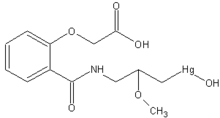- Mercurial diuretic
-
Mercurial diuretics are a form of renal diuretic[1] containing mercury.
Although previously widely used, they have largely been superseded by safer diuretics such as thiazides, and are hardly used anymore.
Contents
History and mechanism
Inorganic mercury compounds, such as mercury(I)chloride (calomel), were found to have diuretic properties when they were used to treat syphilis.[2] Proposed use of these compounds date back at least to the 16th century, shortly after the beginning of the syphilis epidemic in 1497 following Colombus' return to Europe.[3]
Mercurial diuretics cause diuresis by reducing the reabsorption sodium in the ascending loop of Henle, thus causing more water being delivered to the distal convoluted tubule. Unfortunately, earlier physicians misconstrued hallmark symptoms of mercury poisoning such as excessive salivation as signs of mercury's efficacy, including up until the early 1960s when the use of mercurial diuretics were halted in medicine.
Side effects
Due to the idiosyncratic nature of mercury toxicity, the risk of severe disease and sudden death are unpredictable and frequently show no warning signs. Physicians during the 20th century believed that a fever/rash complex suggested the risk of severe side effects for the next upcoming doses if treatment was not halted. Warkany and Hubbard (1953) noted in their seminal paper establishing mercury as the cause of infantile acrodynia that "... in modern times the capricious behavior of mercurial diuretics has been rather disturbing to those who use them frequently. Thousands of injections are given without untoward effects but occasionally a therapeutic dose results in sudden death. Only rarely is this caused by the first dose. More often the patient tolerates several - in one case 164 - doses before the fatal reaction occurs. The mechanism of these reactions is not clear: they can neither be explained nor predicted; yet they cannot be denied."
After finding associations between mercurial diuretics and "mercurial" nephrotic syndrome, in addition to the sharp decline in infantile acrodynia cases after the late 1950s following the removal of many sources of childhood mercury exposure, the dangers of mercurial diuretics were realized. This led to the discontinuation of mercurial diuretics in favor of far less toxic and far more effective diuretics. This is similar to the fashion in which penicillin quickly replaced mercurials, particularly calomel, in the late 1930s as the main antibiotic used in medicine for both children and adults.
Examples
Some common organic mercurials:
- Mersalyl acid (Mersal) (Salyrgan)
- Meralluride[4]
- Mercaptomerin
- Mercurophylline
- Merethoxylline procaine
References
- ^ DALE RA, SANDERSON PH (July 1954). "The mode of action of a mercurial diuretic in man". J. Clin. Invest. 33 (7): 1008–14. doi:10.1172/JCI102967. PMC 438535. PMID 13174657. http://www.pubmedcentral.nih.gov/articlerender.fcgi?tool=pmcentrez&artid=438535.
- ^ Ventura HO, Mehra MR, Young JB (September 2001). "Treatment of heart failure according to William Stokes: the enchanted mercury" ([dead link]). J. Card. Fail. 7 (3): 277–82. doi:10.1054/jcaf.2001.26564. PMID 11561230. http://linkinghub.elsevier.com/retrieve/pii/S1071-9164(01)28406-1.
- ^ Eknoyan G (June 1997). "A history of edema and its management". Kidney Int. Suppl. 59: S118–26. PMID 9185118.
- ^ SANABRIA A (April 1963). "Ultrastructural changes produced in the rat kidney by a mercurial diuretic (meralluride)". Br J Pharmacol Chemother 20: 352–61. PMC 1703643. PMID 13976179. http://www.pubmedcentral.nih.gov/articlerender.fcgi?tool=pmcentrez&artid=1703643.
See also
Antihypertensives: diuretics (C03) Sulfonamides
(except EA)Quinethazone • Clopamide • Chlortalidone • Mefruside • Clofenamide • Metolazone • Meticrane • Xipamide • Indapamide • Clorexolone • FenquizonePotassium-sparing (at CD) ESC blockersOsmotic diuretics (PT, DL) VAs (DCT and CD) Other Categories:- Diuretics
Wikimedia Foundation. 2010.

